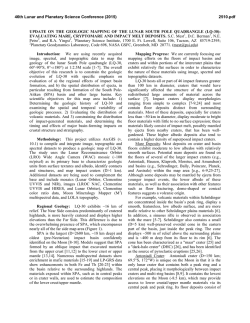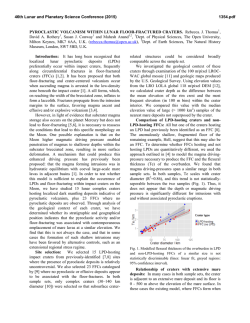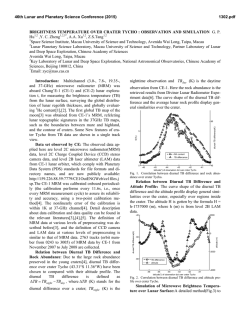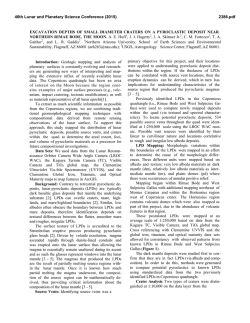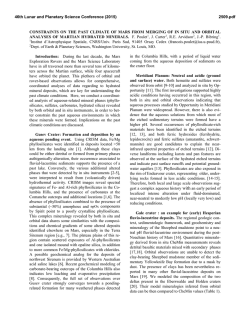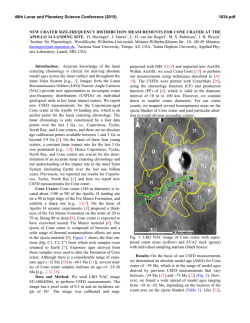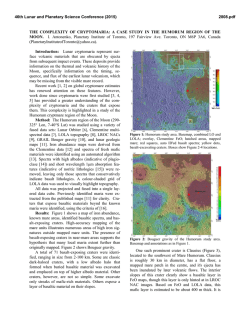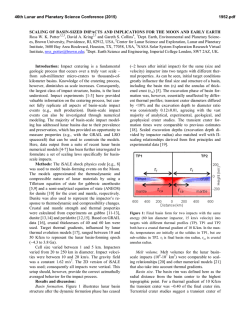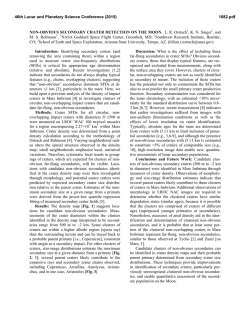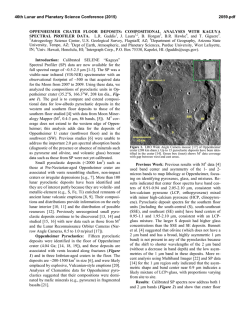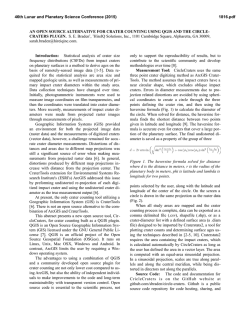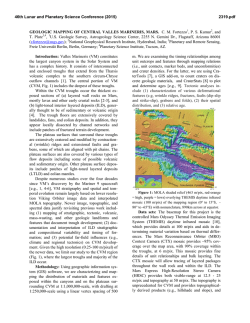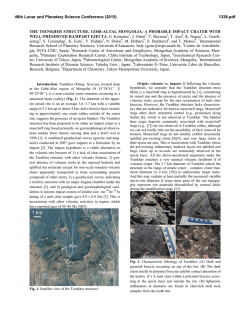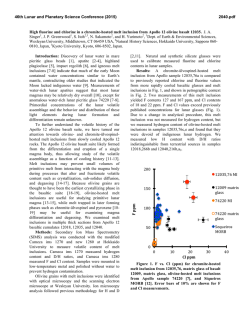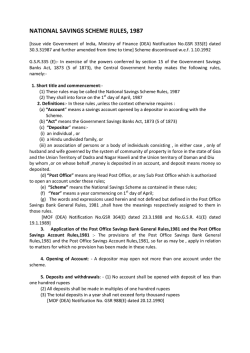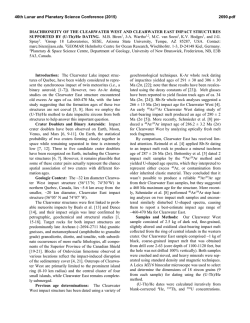
Impact Melt Deposits at the Antipodes of Tycho and Copernicus
46th Lunar and Planetary Science Conference (2015) 2738.pdf Impact Melt Deposits at the Antipodes of Tycho and Copernicus Craters ¨ 1 , 1 Earth, Planetary, and Space Sciences, University of California, Los J.-P. Williams1 , D. A. Paige1 , P. Jogi Angeles, CA, 90095, USA ([email protected]) Introduction: A region on the lunar farside has been identified as unusually rocky in Diviner rock abundance maps and MiniRF CPR and backscatter images [1][2]. LROC images show the region contains remarkable deposits of material that appear to have been originally fluid in nature when emplaced as the deposits consists of flat, ponded material in topographic depressions and veneers on sloped surfaces with evidence for down-slope movement. Rocky surfaces typically are associated with young craters and their ejecta and the ponded nature of these deposits is similar to impact melts commonly observed around many craters. The elevated rock abundance of this area indicates these deposits are relatively young as rocks are broken down on relatively rapid time scales [3]. No obvious adjacent source crater can be identified and two distinct azimuth angles for the delivery of materials have been identified in the Diviner rock abundance [1]. The proximity of the region to the antipode of the crater Tycho, has led to the suggestion that the deposits result from the focusing of material ejected during the Tycho impact event. Tychos antipode is on the eastern edge of the region with the center of the deposits offset to the west. Modeling of ballistic trajectories of debris launched by Tycho, accounting for rotation of the Moon during the time of flight, predicts a consistent location for antipodal deposition offset to the west of the true antipode [4]. ¨ and Paige [4] also found that frictional heating Jogi of the accumulating antipodal material would impart enough energy to melt accumulating deposits. If these deposits are the result of an antipodal accumulation of material from the Tycho impact event, then other similar deposits should exist at the antipodes of other large, young craters. Such a candidate deposit has been identified near the antipode of Copernicus with an offset to the west, con¨ and Paige [4]. sistent with the modeling of Jogi Copernicus antipode: Impact ponds and flows near Keeler crater were initially identified in MiniRF by Carter et al. [2]. This region does not show a distinctly elevated rock abundance, however ponded material similar to the Tycho antipodal region is evident in LROC images (Fig 1) and superposed impacts excavate blocky material beneath an apparent thin accumulation of regolith indicating the deposits are comprised of competent rock at shallow depths (Fig 2). Figure 1: Flat floored deposit near Copernicus antipode. Figure 2: Blocks of material excavated by impact near Copernicus antipode. Crater counts: We have conducted crater counts on the melt deposits on the ejecta blankets of Tycho and Copernicus craters and several of the antipodal flat-floored deposits (Fig 3 and 4). Both Tycho and Copernicus have substantial impact melt deposits near their rims. Using the Lunar cratering 46th Lunar and Planetary Science Conference (2015) 2738.pdf Figure 3: Crater counts and absolute model ages [5] for a melt deposit near the rim of Tycho and two melt ponds near the Tycho antipode. Figure 4: Crater counts and absolute model ages [5] for a melt deposit near the rim of Copernicus and two melt ponds near the Copernicus antipode. chronology of Neukum et al. [5], we obtain crater retention ages of 34.3 ± 11 Ma and 192 ± 39 Ma for Tycho and Copernicus respectively, similar to ages derived by crater counts conducted by Heisenger et al. [6]. These ages are younger than the ages derived from crater counts conducted on the clastic ejecta of the craters or the cosmic-ray exposure ages derived from Apollo samples of 109 ± 4 Ma for Tycho and 800 ± 15 Ma for Copernicus [7]. This discrepancy may reflect differences in target material properties with the impact melt presenting a more competent target with higher yield strength resulting in smaller crater diameters for a given impact energy [8]. Crater counts on the antipodal deposits yield similar ages to the counts conducted on the melt deposits near the rims of Tycho and Copernicus craters with ages 31.2 ± 5.1 Ma and 35.4 ± 5.3 Ma obtained for two of the melt ponds at the Tycho antipode and 253 ± 140 Ma and 269 ± 61 Ma for counts on two melt ponds at the Copernicus antipode. becomes appealing and would imply that material ejected by large impact events may preferentially accumulate near their antipodes. Discussion: With the recognition that both Tycho and Copernicus possess possible antipodal impact melt deposits at locations predicted by ballistic modeling [4], and that crater counts indicate similar formation ages to impact melt deposits proximal to the craters, an antipodal origin for these deposits References [1] J. L. Bandfield, et al. A highly unusual series of young impact melts and rocky exposures antipodal to Tycho crater. Lunar Planet. Sci. Conf., 44th, 2013. [2] L. M. Carter, et al. Initial observations of lunar impact melts and ejecta flows with the Mini-RF radar. J. Geophys. Res., 117, 2012. doi:10.1029/2011JE003911. [3] R. R Ghent, et al. Constrains on the recent rate of lunar ejecta breakdown and implications for crater ages. Geology, 42, 2014. doi:10.1130/G35926.1. ¨ and D. A. Paige. Directed cratering ejecta bal[4] P. Jogi listic model for antipodal impact, fictionally heated, melt deposits on the Moon. Lunar Planet. Sci. Conf., 46th, 2015. [5] G. Neukum, et al. Cratering Records in the Inner Solar System in Relation to the Lunar Reference System. Space Sci. Rev., 96:55–86, 2001. [6] H. Hiesinger, et al. How old are young lunar craters? J. Geophys. Res., 117, 2012. doi:10.1029/2011JE003935. ¨ [7] D. Stoffler and G. Ryder. Stratigraphy and isotope ages of lunar geologic units: chronology standard for the inner solar system. Planet. Space. Sci., 96:9–54, 2001. [8] K. A. Holsapple. The scaling of impact processes in planetary science. Ann. Rev. Earth Planet. Sci., 21:333– 373, 1993.
© Copyright 2025
